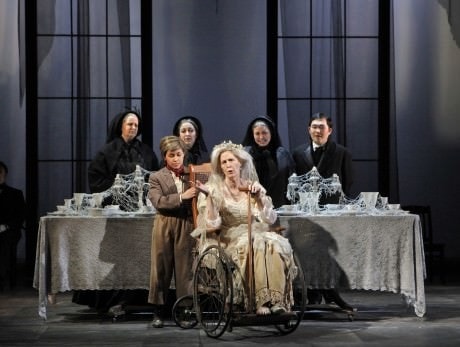There are certain characters in literature that, for whatever reason, capture the imagination, whether for good or ill. Miss Havisham, with her decaying wedding dress and moldering wedding feast, has always been one of those characters -one that intrigues and interests all those who come across her. Yet many times, in our interest in the trappings of Miss Havisham’s odd life and the consequences of her bizarre actions, we forget that she is a sad, insane woman, doomed to a prison of her own making. Dominick Argento’s Miss Havisham’s Fire, wonderfully brought to life by Linda Mabbs, triumphantly strips away the trappings and leaves us only with the woman – not the interesting character, but the very real, very broken, woman.

The story of Miss Havisham from Charles Dickens’ Great Expectations is a familiar one: as she dresses for her wedding day, she receives a note informing her that her fiancée has run away and abandoned her. She stops all the clocks and lives for 50 years in practical isolation in her decrepit house, never changing out of her decaying wedding dress, until she dies when her wedding gown catches fire. Miss Havisham’s Fire, subtitled “Being an investigation into the unusual and violent death of Aurelia Havisham on the 17 of April in the year 1860” explores her story on two levels: the first, an inquiry into the causes of her death and the second, a series of flashbacks describing the circumstances of her life. As the flashbacks come, the past and present seem to merge and allow us to look past the odd trappings and come to know the woman.

Directed by Leon Major, the overwhelming mood was one of eeriness as all we come to know this once familiar character and recognize in her not a caricature but a human. Argento’s atonal (though not excessively so) music, conducted by Timothy Long, underscored this. There is no clear, obvious melody, nothing familiar for the audience to cling to. Similarly, the staging was very sparse, without excessive sets and only essential plots, relying very much on light and shadow to create the different settings. And it did so wonderfully, thanks to Scenic Designer James Kronzer. The use of light by Lighting Designer Brian MacDevitt was fantastic – the dramatic change in lighting as the young Miss Havisham receives the letter from her fiancée jilting her made that moment even more cutting that it already is. Similarly, the lighting used to create the effect of Miss Havisham dying by fire was fantastic – clearly not meant to be realistic, merely suggestive, but even so more effective than had it been done in a realistic manner. Costume Designer David O. Roberts also deserves credit, making the costumes interesting and supportive of each character, despite the bleak color palette.
Yet all the wonderful music, effective lighting and staging would have been for naught without the combined efforts of the fantastic cast. Linda Mabbs as Aurelia Havisham was the clear standout -with her lovely, clear soprano, she conveyed Miss Havisham’s simultaneous strength and vulnerability, madness interspersed with moments of extreme self-awareness, in a touching and genuine manner. Similarly, Alex DeSocio as Pip brought a plaintive sincerity to his role that contrasted and complimented Ilene Pabon’s eerie Estella. Other standouts included Patrick Cook as Bentley Drummle, Emily Kate Naydeck as Young Aurelia, and Teresa Ferarra as Young Pip, though truly the entire cast is worthy of accolades.
While modern opera may not be everyone’s favorite thing, Miss Havisham’s Fire is one opera everyone should see. At tonight’s production, we were fortunate enough to have the composer himself – Dominick Argento – in the house, and he was brought out to take a bow at the curtain call. I found myself rising to my feet, giving both him, and all those involved in this production, a well-deserved standing ovation.
Running Time: Approximately two hours and 30 minutes, with one 20 minute intermission.

Miss Havisham’s Fire plays through Sunday, April 29, 2012 at the Clarice Smith Performing Arts Center at University of Maryland – at the intersection of Stadium Drive and Route 193, in College Park, MD. For tickets, call (301) 405-ARTS (2787) or order them online.




